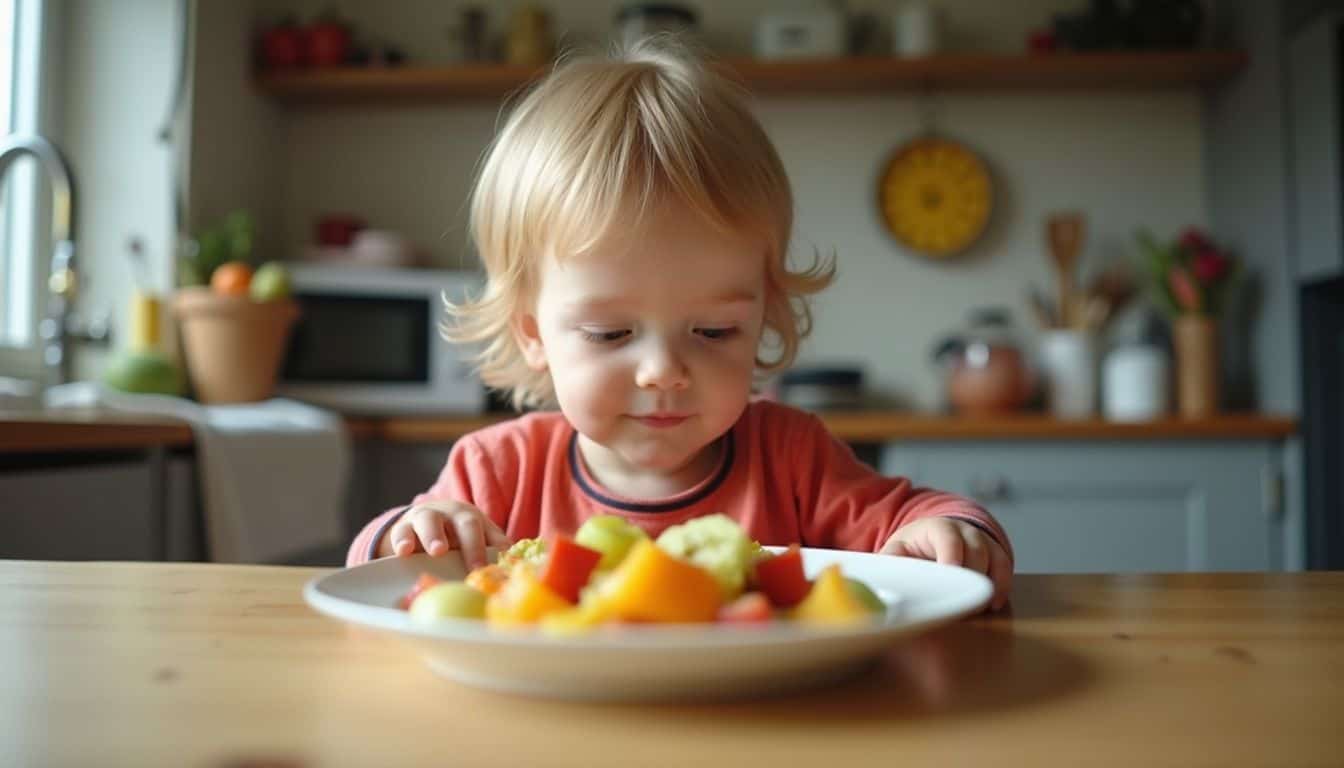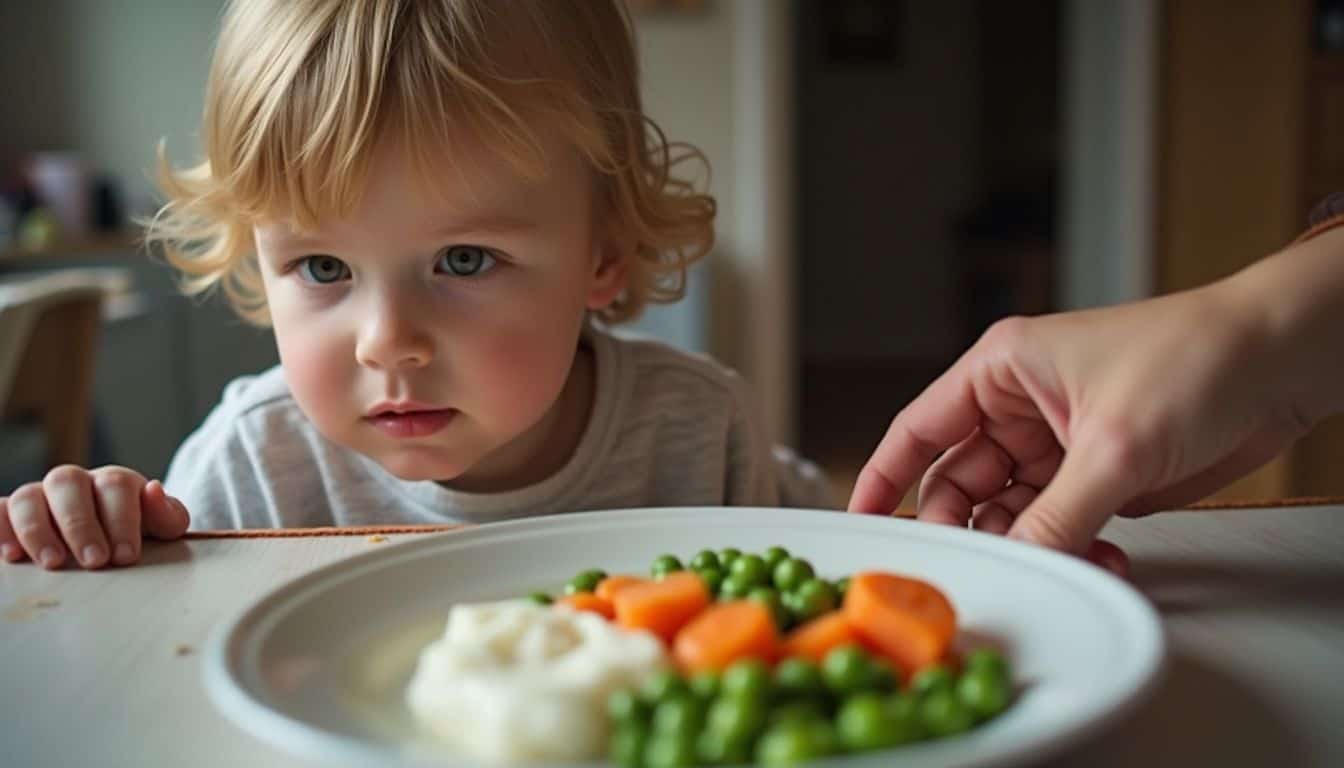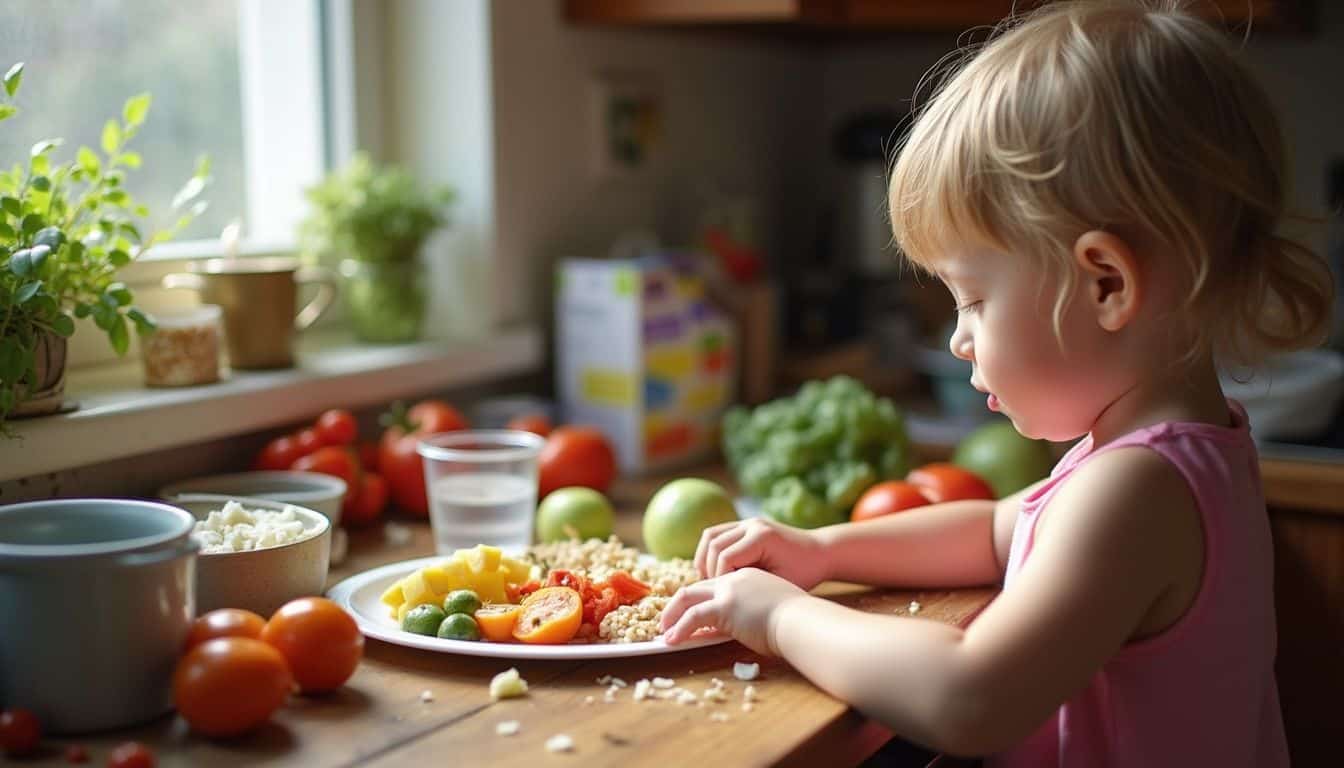Searching why your child is so fussy with food can feel exhausting. You are not alone. Picky eating is common in early child development, and it has real, fixable causes.
This guide explains why kids form strong food preferences, what food neophobia means, and how family routines shape eating. You will get simple steps that lower stress and help a picky eater try more foods.
Key Takeaways
Fussy eating peaks between ages 2 and 4, often due to normal food neophobia and genetic taste sensitivity.
Most kids need 8–15 exposures to a new food before acceptance. Many adults stop after only 3–5 tries.
Delaying solids past 9 months and frequent sugary snacks raise feeding problems and lower fiber, iron, and zinc intake.
Picky eating that persists after age 4, or cuts whole food groups, may need early support from a pediatrician or dietitian trained in exposure therapy.
Calm routines, positive modeling, and repeated exposure improve variety and nutrition in current pediatrics research.
Table of Contents
What Does Fussy Eating Mean and How Common Is It?

Fussy eating, often called picky eating, shows up most between ages 2 and 4. Kids may reject foods due to taste, texture, smell, or because something new looks odd.
This phase can act like a safety system. It keeps young children from eating unsafe things while they explore. Most children accept a new food after 8 to 15 friendly exposures. Many caregivers stop too early due to stress or worry.
Up to half of young kids go through this stage at some point. Picky eaters often eat fewer fruits and vegetables, which can lower vitamins and fiber.
At home, variety helps. Meal kits or simple sides can keep options fresh, such as Taylor Farms onion kits for easy flavor.
Ongoing fussy eating can raise the risk of nutritional deficiency and affect growth or learning. Early action with simple, research-based strategies is best.
Causes of Fussy Eating in Children

Reasons vary. Hunger shifts, texture or smell sensitivity, past illness, and family habits all matter. Genetics and temperament influence a child’s food intake from infancy, including during breast-feeding.
How Do Natural Development and Taste Preferences Affect Eating?

Taste develops early. Many children show food neophobia, the fear of new foods, around ages 2 to 4. It serves a protective purpose during exploration.
Genes shape taste. Some kids are highly sensitive to bitterness, which makes some vegetables hard to accept. Sensory sensitivity to smell, texture, or temperature can also push children to reject strong odors or fibrous greens.
Taste buds change over time. What seems fine this month may taste different later.
Feeding practices matter. Permissive parents might offer sweets or snacks when faced with pushback. That pattern makes it harder to meet estimated average requirements for fiber and key micronutrients.
If picky eating persists, early support helps. It protects variety later in adolescence and reduces low intakes of fruit and vegetables.
What Is Neophobia and How Does It Impact Food Choices?

Neophobia is the fear of new foods. It peaks from ages 2 to 4, which lowers fruit and vegetable intake in many families.
Parents often stop offering a new food after a few tries. Research shows 8 to 15 exposures are usually needed.
Children with high sensory sensitivity tend to be more selective. That increases the risk of low iron and zinc, which are important for growth and attention.
Caregivers who eat fruits and vegetables themselves raise acceptance. Positive modeling may also reduce longer-term risks linked with avoidant or restrictive eating patterns.
How Does Sensitivity to Taste, Smell, and Texture Influence Eating?

Some children react strongly to flavor, odor, and mouthfeel. This sensory sensitivity can lead to rejecting strong smells or fibrous textures like broccoli or mushrooms.
Mixed dishes can feel overwhelming, so casseroles or stews may be tough. Genetics play a role in picky eating, especially when aversions link to taste and texture.
Pressure at meals often makes it worse. It can trigger meltdowns that become a pattern.
Early, gentle exposure to solids, including vegetables, lowers risk of ongoing feeding difficulties. Gradual exposure therapy plus praise can help kids accept new foods without anxiety.
Why Do Appetite Changes Occur During Growth?

Growth spurts raise energy needs, so appetite goes up. Kids may eat more during these times to build fat mass and muscle.
During slower growth, appetite drops. This can worry adults who fear underweight, obesity, or disordered eating like anorexia nervosa or bulimia.
Pressure to finish plates harms self-regulation. It can dull natural fullness cues and heighten stress.
Appetite swings support healthy cycles in BMI and body fat across childhood. Needs shift with sports, school, and sleep.
Children’s hunger follows growth. Bigger gains mean bigger appetites, slower phases mean less interest in food.
Learned Behaviors That Lead to Fussy Eating

Children copy caregivers without trying. Emotions, anxiety, and past stomach pain can shape how they react to new foods.
How Do Children Mimic Parental Eating Habits?

Caregivers set the tone. Kids watch closely, copy attitudes, and match food choices. If an adult avoids vegetables, children often follow.
Food neophobia can grow after seeing adults reject new dishes or show disgust at certain textures like tough greens.
Shifting your own snacks to whole fruit can influence requests. A diverse adult plate encourages kids to taste more foods without pressure.
Offering many foods early shows that variety is normal. Critical comments about baby foods or veggies can build fear or obsession with only a few items.
Next up: What Are Negative Food Associations and How Do They Develop?
What Are Negative Food Associations and How Do They Develop?

Negative links form fast. A child who gags on peas or feels stomach pain after dairy can start to fear those foods.
Pressure cements the fear. Kids with strong reactions to smell, taste, or texture are at higher risk for anxiety around meals.
Forcing bites often backfires. A child may avoid even once-loved foods after a bad meal experience.
A gentle approach and steady exposure make the table feel safe, not like a fight.
In severe cases, social life suffers. Some children avoid parties out of fear of the food served. Cognitive-behavioral therapy, called CBT, can help rebuild trust and allow slow, safe trials.
How Does a Child’s Desire for Control Affect Eating?

Kids test independence at the table. Saying no can feel like control, especially in toddler and preschool years.
Control struggles often clash with caregiver pressure or restriction. That tug-of-war can turn into long-term picky eating.
Over time, this pattern can reduce nutrient intake and affect growth. Studies using food frequency questionnaires link extreme control battles with underweight or slow gains.
Calm structure helps. Offer choices, give small portions, and use gradual exposure to lower anxiety without bribes or punishments.
Environmental and Social Factors Affecting Eating

Family routines, school settings, and parenting styles all shape eating. Siblings often influence little ones by modeling what they eat.
How Do Peers Influence a Child’s Food Choices?

Children copy friends. Group excitement can make a new dish seem safe and fun.
In groups, many kids agree to try one bite. Family meals and playdates are ideal times for low-pressure tasting.
Older siblings can lead by example. On the downside, peer snacks can be sugary, which may worsen constipation in sensitive kids.
Encouraging relaxed, social eating boosts acceptance and supports mental health linked to food.
Children learn a lot about food by watching others enjoy it.
Kids introduced to solids late often mirror peers with similar limits, especially if sensory sensitivities run in the family.
What Happens When Solid Foods Are Introduced Late?

Timing matters. Starting solids after 9 months often raises feeding issues and picky eating by age three.
Late introduction of lumpy or textured foods can slow acceptance of new flavors. Babies who wean early from breast milk and also start complementary foods late face higher refusal risk.
Persistent picky eaters often eat less fiber, which affects digestion and health. Offering vegetables between 4 and 5 months, as advised by your clinician, may lower future fussy eating scores.
Caregiver attitudes during pregnancy can shape later openness to flavors. Starting solids on time supports growth, healthy weight, and better long-term variety.
How Does Excessive Snacking Impact Appetite?

Too many snacks, especially sugary ones, blunt true hunger at meals. Small stomachs fill fast.
When children graze, they often pick the same safe foods. That limits nutrients found in balanced family meals.
Snack timing is key. Offering food too close to dinner feeds ongoing picky patterns. Set a cutoff time so children arrive hungry and curious.
Why Can Pressure at Mealtimes Make Eating Difficult?
Pressure raises anxiety and resistance. Forcing bites or bribing with dessert can turn meals into battles.
Stressful tables lower interest in new foods and fiber-rich options. This can harm nutrition and social comfort around food.
Kids with ADHD or on the autistic spectrum may feel extra overwhelmed. Neophobia grows stronger under stress.
Relaxed routines help. Many kids accept a new food after about 10 to 15 calm exposures.
What Are the Consequences of Fussy Eating?

Limited diets can reduce fiber and key nutrients. That affects energy, focus, and activity.
How Does Fussy Eating Limit Nutrient Intake?
Children who avoid many foods often miss iron, zinc, protein, and fiber. Skipping meat, fish, fruits, or vegetables lowers overall intake.
Poor variety makes daily needs hard to meet. Long-term picky eating raises the risk of being underweight and can slow growth.
Early vegetable exposure protects against later picky habits. Gaps in nutrition may affect body health and emotional well-being.
Caregiver stress, education, and access to food are social determinants that also shape eating over time.
What Are the Effects on Growth and Development?
Less variety can mean too little iron and zinc, both vital for growth. Many picky eaters get too little fiber, which can lead to constipation.
Picky eating at age seven links with possible developmental concerns, though not always with behavior problems.
Constant nutrient gaps can slow height or healthy weight gain. Constipation adds discomfort and can further cut appetite.
Early help and a diverse diet reduce these risks across different temperaments, including children on the autistic spectrum disorders.
How Can Mealtimes Become Socially Challenging?
Fussy eating can strain birthdays, playdates, and family dinners. Watching a child refuse every dish can feel isolating.
Arguments may rise between siblings or caregivers. Some families avoid events with shared meals to prevent scenes.
Gagging or panic at certain foods raises anxiety for everyone. Low intake can worsen worries about health and growth.
Public pressure makes pushing tempting, but it rarely helps. A calm, respectful approach supports both nutrition and confidence.
How Can Parents Address Fussy Eating?

Consistent routines, empathy, and patient exposure work well. A pediatrician or registered dietitian can help with persistent fussy eating.
Why Is Introducing a Variety of Foods Early Important?
Early variety builds comfort with new tastes and textures. Expect 8 to 15 tries for many foods.
Caring adults who enjoy produce raise acceptance. Siblings often inspire tasting, which supports long-term healthy eating.
Early solids also reduce neophobia, the fear of new foods. A wide mix protects against choking worries and later refusal.
Many cultures offer diverse flavors from infancy. That pattern creates strong, lifelong habits.
How Does Repeated Exposure Help with New Foods?
Kids often need to see and taste a food many times. Most caregivers quit after only a few tries, but persistence wins.
Serve the same vegetable at different meals without pressure. Familiarity lowers anxiety and builds curiosity.
Use non-food rewards like stickers to boost motivation. Keep limits clear and gentle to prevent emotional blowups.
Progress happens over weeks, not days. Small steps add up.
How Can Parents Create a Relaxed Mealtime Environment?
Set regular meal times and reduce distractions. Turn off the TV, silence phones, and keep toys away.
Routines signal that meals are family time. Modeling healthy eating shows a positive attitude toward food.
Avoid pressuring bites or clean plates. Encourage tasting, then let the child decide how much to eat.
Limit sugary drinks and snacks before meals. A hungry child is more open to new foods.
Next, see why using food as a reward or punishment can backfire.
Why Should Food Not Be Used as a Reward or Punishment?
Food-based rewards build negative links with eating. Children may eat to please adults, not to satisfy hunger.
That pattern dulls natural hunger and fullness cues. It can lead to unhealthy relationships with food or disordered eating later.
Offering candy for good behavior shifts focus from nourishment to control. Kids may learn to negotiate with treats.
Skip reward food. Build pressure-free routines that make tasting feel safe and normal.
Practical Tips for Managing Fussy Eating

Small changes add up. Use these daily strategies to support healthy habits and ease stress.
How Can Involving Children in Food Prep Help?
Helping in the kitchen builds ownership and curiosity. Measuring, mixing, or washing produce makes tasting more likely.
Cooking together improves nutrition knowledge and lowers food neophobia. Let kids choose between two vegetables or two sauces.
Offer simple wins. For example, let your child stir a yogurt dip for cut veggies. See more ideas at practical dinner solutions for picky eaters.
Shared prep brings laughter and connection. Mealtime becomes something to enjoy.
What Are Age-Appropriate Portion Sizes?
Children need smaller servings. A helpful guide is one tablespoon of each food per year of age for toddlers.
Preschoolers can have a quarter to a half cup of cooked vegetables, grains, or protein at meals. Offer milk in small cups.
Use small plates so portions feel manageable. Let kids scoop their own food when possible.
Right-sized servings reduce pressure and power struggles. They also support healthy self-regulation.
Next up: why easing off pressure often improves eating.
Why Is It Important to Avoid Pressure to Eat?
Pressure makes meals stressful. Gentle exposure and time create lasting change.
Many kids need 10 to 15 exposures to accept something new. Forced bites often delay progress.
Use non-food rewards like stickers or extra story time. Keep the mood light with simple chat and modeling from adults.
Children who feel safe near new foods build better attitudes. That supports balanced nutrition and calmer meals.
How Does Limiting Snacks Before Meals Help?
Stop snacks at least two hours before mealtime. True hunger increases interest in new foods.
Set a routine with clear meal and snack times. Kids learn to expect food at regular intervals.
Diet quality improves when children eat the meal served. Over time, families see fewer battles and more tasting.
When Should Parents Seek Professional Help?

See a pediatrician or registered dietitian if you see weight loss, extreme distress, or very limited diets. Early help protects growth and reduces family stress.
What Is Considered Persistent or Severe Picky Eating?
Concern grows when picky eating lasts past age 4, or when whole food groups are refused. Strong reactions like gagging or tantrums are red flags.
Children often need 8 to 15 exposures before saying yes to a food. Stopping early can let the behavior stick.
Severe picky eating can cause vitamin and mineral gaps and slow weight gain. Professionals may suggest exposure-based cognitive-behavioral techniques and nutrition support.
Early intervention builds comfort with textures and tastes while protecting growth.
What Are the Signs of Nutritional Deficiencies?
Watch for low energy, pale skin, brittle nails, frequent illness, and slow growth. These signs can point to missing iron, zinc, or other nutrients.
Refusing new foods and dropping once-liked foods can also signal risk. Constipation is common with very limited diets.
Track patterns and bring notes to your child’s clinician. Quick action prevents bigger problems.
When Are Emotional or Behavioral Issues Related to Food a Concern?
Sometimes food issues reflect anxiety or rigid routines. If meals bring extreme distress, or entire food groups vanish, seek help.
Long-lasting patterns that affect health or daily life need care. A child who eats only a few safe foods for weeks may not meet needs for iron and zinc.
Registered Dietitians and therapists use tools like the Child Eating Behavior Questionnaire to guide care. Support can be brief and very practical.
How Will Our Understanding and Management of Fussy Eating Evolve in 2025?

Experts expect fresh insights on how sensory preferences drive acceptance. Many clinics use meal tracking apps and AI-guided plans to spot patterns and set small, realistic goals.
Parents will see more family-based coaching. Group visits may include stories, games, and tasting practice. Classrooms may add mindful snack time to build curiosity and calm.
As research grows, you gain more simple, low-pressure ways to support a picky eater. For health questions or growth concerns, always talk with your child’s clinician. This article is educational and not medical advice.
People Also Ask
What are the main reasons my child is so fussy with food?
Children often refuse certain foods due to sensory sensitivities, a desire for control, slow adaptation to new tastes, or past negative experiences at mealtimes. Sometimes, medical issues like reflux or allergies can also cause picky eating.
How do I know if my child’s fussiness is normal or a sign of something serious?
Most children go through phases of selective eating as they grow and explore independence. If your child eats from all major food groups over time and grows well, this behavior is usually typical. However, if you notice weight loss, fatigue, or signs of nutritional deficiency such as pale skin or frequent illness, consult your pediatrician.
What practical solutions help reduce picky eating in kids?
Offer small portions of new foods alongside familiar favorites; avoid pressuring your child to eat everything on their plate. Make meals relaxed and consistent by serving family-style dishes where everyone chooses what they want to try. Involve your child in meal planning and preparation since participation can increase interest in different foods.
Can emotional factors make my child more selective about food?
Yes; stress at home or school may lead children to seek comfort by sticking with familiar meals while rejecting others. Creating positive routines around mealtime helps ease anxiety and encourages openness toward trying varied options over time.
